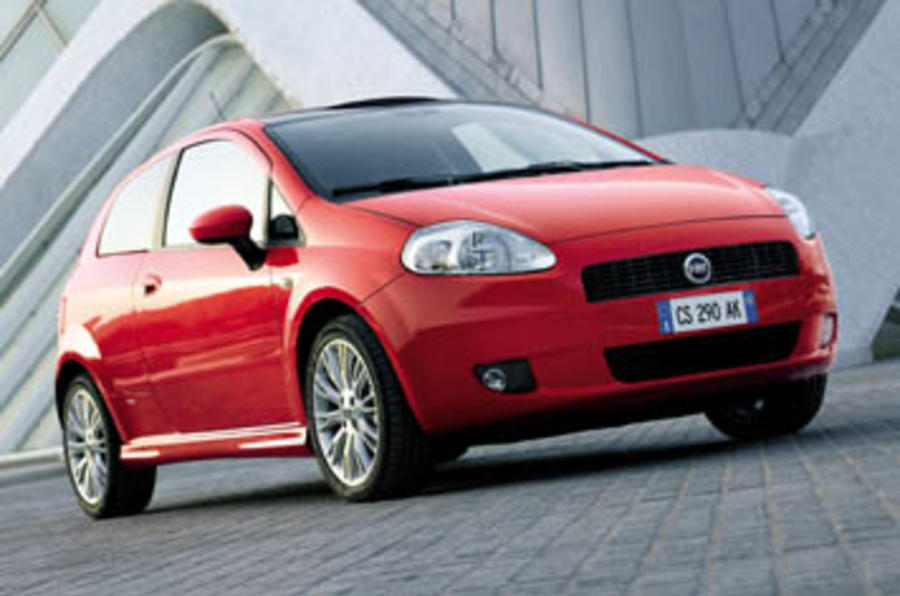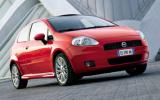‘Whump.’ That’s the noise that a Punto door makes when you close it. This car is a robust, well-made object, a car that inspires confidence. Though this probably won’t be what you first think when you see Fiat’s all-new Punto. Instead, you may well be struck by what an attractive, pretty and Italian-looking car this is. Sporty, too. And that’s quite a novelty for a Fiat, which has long been a producer of cheap, functional cars that have increasingly appeared to have bypassed Italy’s famed talent for design. This new Punto, however, bears more than a little of the flair you’d hope for from a car made in Italy. Its exterior design is the work of Giorgetto Giugiaro, and it’s our view that he has sculpted a supermini to rival the pretty 206 for visual appeal. That the grille and elegantly elongated headlamps lend its nose the look of a Maserati Coupe – also designed by Giugiaro - is coincidental, but it’s a comparison Fiat is happy to live with. The big, back-swept headlights do a good job of hiding a nose whose length has been stretched by the requirements of the pedestrian impact test, in the process making the Punto decisively the biggest supermini in its class, though happily, some of the extra length lies between the axles, promising generous lounging room. The rear view is just as pleasing. The Punto’s trademark high-mounted taillights return in racier form, while the tailgate is decorated only with the Fiat badge and an appealingly redesigned Punto label, to create a look that is both clean and classy. So keen were the designers to unclutter the tailgate that it does without a handle – instead, a small spring pushes the hatch upwards slightly when you release it, enabling you to get a paw underneath. It’s attention to detail like this that demonstrate Fiat’s commitment to getting this car right, which it needs to be of course, because this company has been wading through deep red ink for several seasons now, and while it has nearly reached the shores of profit, a failure with its staple model will soon see it floundering again. The all-new Punto rides on an all-new platform – shared with the upcoming Opel Corsa - but it uses existing engines and the very familiar suspension layout of MacPherson struts up front, and a twist beam axle at the rear. Fiat claims that the bodyshell is the most rigid in its class, and extensively modified production machinery to ensure that it can be built to the same precise tolerances week-in, week-out. Up front, the suspension lower arms are of lighter pressed steel rather than cast-iron, the suspension bushes are much larger for improved small bump absorption, while an extra-rigid front subframe maintains the suspension geometry during the stresses of hard cornering. Dual-path strut mounts dampen road noise more effectively, while the springs are mounted to reduce friction within the dampers. At the back-end, the torsion beam axle is mounted more rigidly, while varying the thickness of the twist-beam itself, depending on the model, has allowed the rear anti-roll bar to be ditched altogether, saving weight, and the dampers are now vertically-mounted to reduce road roar. The steering gear is much the same as before too, which means two levels of electric power assistance, the handy push-button Dualdrive mode reducing effort for urban manoeuvres. The engine range is surprising for providing – for the moment at least – just two petrol units. The smallest of these is a 1.2-litre eight-valve FIRE engine of 64bhp, while a new 1.4 version of the same unit, producing 76bhp, is likely to be a best-seller in the UK. But the really advanced technology comes with the diesel engines, Fiat exploiting the common rail technology that it invented with a range of Multijet engines beginning with the familiar 74bhp 1.3. New is a 89bhp version of the same engine, the extra power extracted via a variable-vane turbocharger. Top of the range is a diesel 1.9 JTD of 118bhp in its standard form or 128bhp in Sporting trim, both yielding a 207lb ft surge of torque. You get a six-speed gearbox with every Punto as well as assisted steering, anti-lock brakes with EBD, an electric tailgate release, electric front windows and remote central locking, a trip computer, follow-me-home headlights and a rake-and-reach trimmable wheel. But while you also get twin dual-stage front airbags, the side and curtain bags that enabled the Punto to score the best-ever rating in the euroNCAP crash tests do not come with the basic Active model in Italy, though UK specifications may yet get them. The six-bag Punto tested by euroNCAP nevertheless scored the full five stars for adult impact protection, three stars for child occupant protection and three for pedestrian. Which is very impressive. So is climbing aboard an orange-trimmed Punto. Not only are the attractively embossed seat centres upholstered with it, but the dashboard too, a broad band of metallic orange spanning the facia and circumnavigating the centre console. It looks classy, warms the interior up and makes the Punto a cabin a pleasant place to be. It is also comfortable. You enjoy that big-car feel, not only because there’s ample room up front, but also because the base of the screen lies some distance across a plain of upper dashboard, creating the feel of an MPV. It’s less airy in the back – the rear pillar is a thick one, and the side window is shallow – but there’s plenty of space, making a long back-bench journey a perfectly palatable prospect for adults. On the move in the 1.4, the Punto comes over as a civilised device. The engine’s note is well-muffled until it rises high, its noise turning lightly peppy past 5000rpm, and the ride is quiet - you’ll think exceptionally so if you’re used to a Fiat’s crashing way with bumps. This new Punto’s extra suspension compliance works wonders, the system balming away most sharp impacts with aplomb. Very occasionally you can faintly sense the quivering shake over sharp ridges that has afflicted Fiats for decades, but aboard the 1.4 you’ll have to concentrate to feel it. At high speed the calm is spoiled only by some whoosh from around the mirrors, but otherwise this car is a relaxed cruiser. It would be more so if the engine could provide extra pace – 76bhp should be plenty in a supermini, but this big little Fiat weighs in it at 1025kg, which is perfectly competitive, but not light. If you want mid-range urge then, you need a diesel. And all three, including the 74bhp entry 1.3 Multijet, offer it. In the base engine you’ll sometimes wait for the turbo to spool up, and with its surge comes diesel cackle that’s too intrusive, but once you’ve reached a cruise it quietens down. You’ll find the same characteristics in all three engines, but it’s the 118bhp 1.9 that delivers any real excitement. But the 1.9 JTD is not the best Punto, because it carries an amazing extra 180kg over its front wheels compared to the 1.4 petrol. This, and its bigger wheels, mean that it falls into potholes more thumpingly and that it loses quite a lot of the tidy handling balance that the 1.4 offers. The 1.4 handles well in fact, and if there’s not much scope for adjusting its line with the throttle, it tracks faithfully and generates useful grip. That it lacks that final sensitivity is mostly down to the feelless electrically assisted steering, though word is that a new system, in which the motor is mounted on the rack rather than within the steering column, will improve matters in around a year. The rest of the range offer a compromise somewhere between these two extremes – the 74bhp 1.3 Multijet carries an extra 75kg over the front wheels and is slightly less deft in bend and slightly clumpier into potholes, while the 89bhp version of the same engine, carrying 35 kilos more, is fractionally less impressive still. But unless you’re super-sensitive to these things, the 1.3 Multijets make a good compromise if you can live with their occasionally insistent clatterings, the 90bhp version proving rather brisk (62mph comes in 11.9sec) and barely any less economical. But if the dynamic variations between these cars are a little disappointing, we are nevertheless impressed with this new Punto, for its Latin design flair, its air of solidity, the pleasure of sitting in it, its safety credentials and its completeness. It may be rather big for a supermini, but it’s also a little glamorous, and that’s a rare commodity in this class.
Large dynamic variations between the different engine options, but an appealing car both to look at and to be in
Close
Back to top






























Add your comment